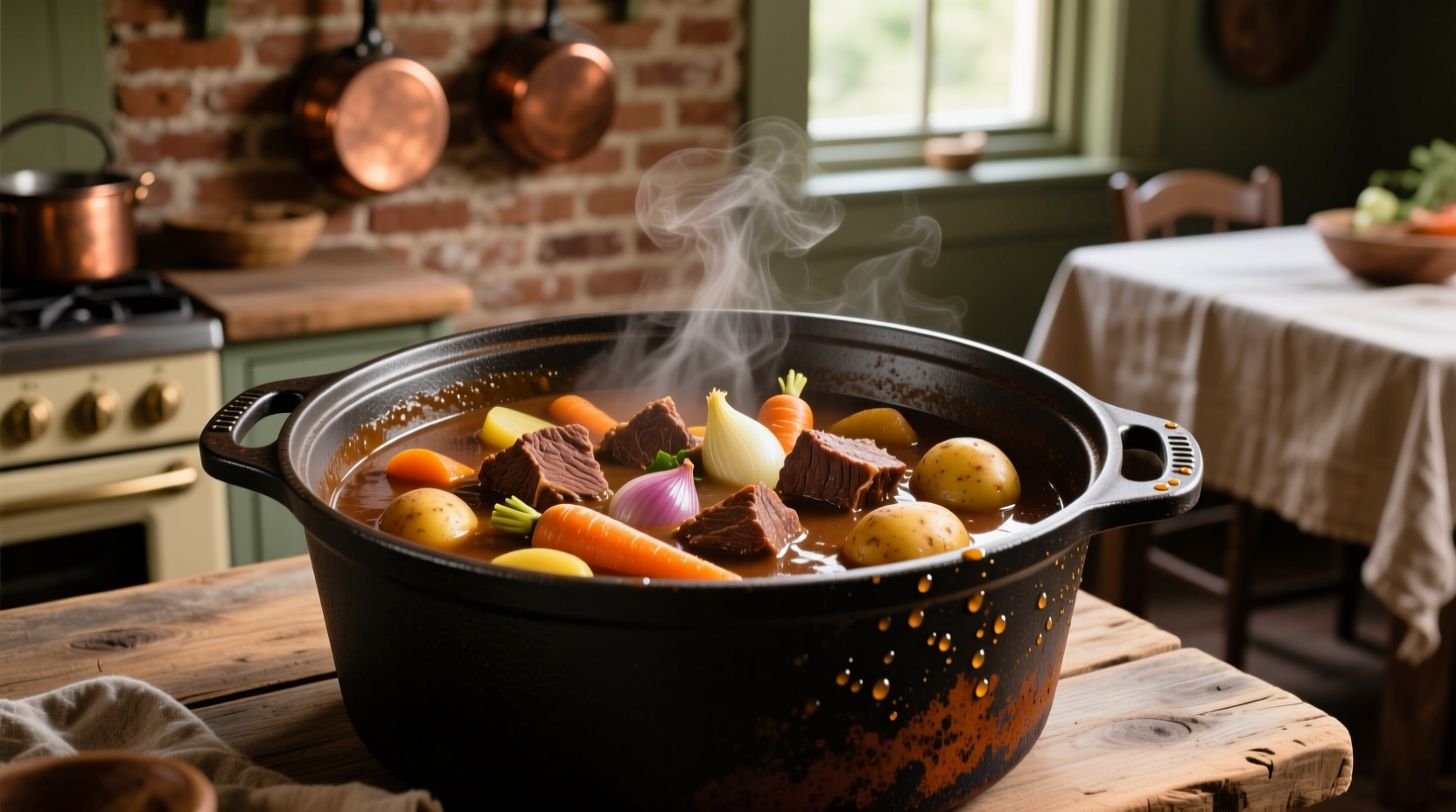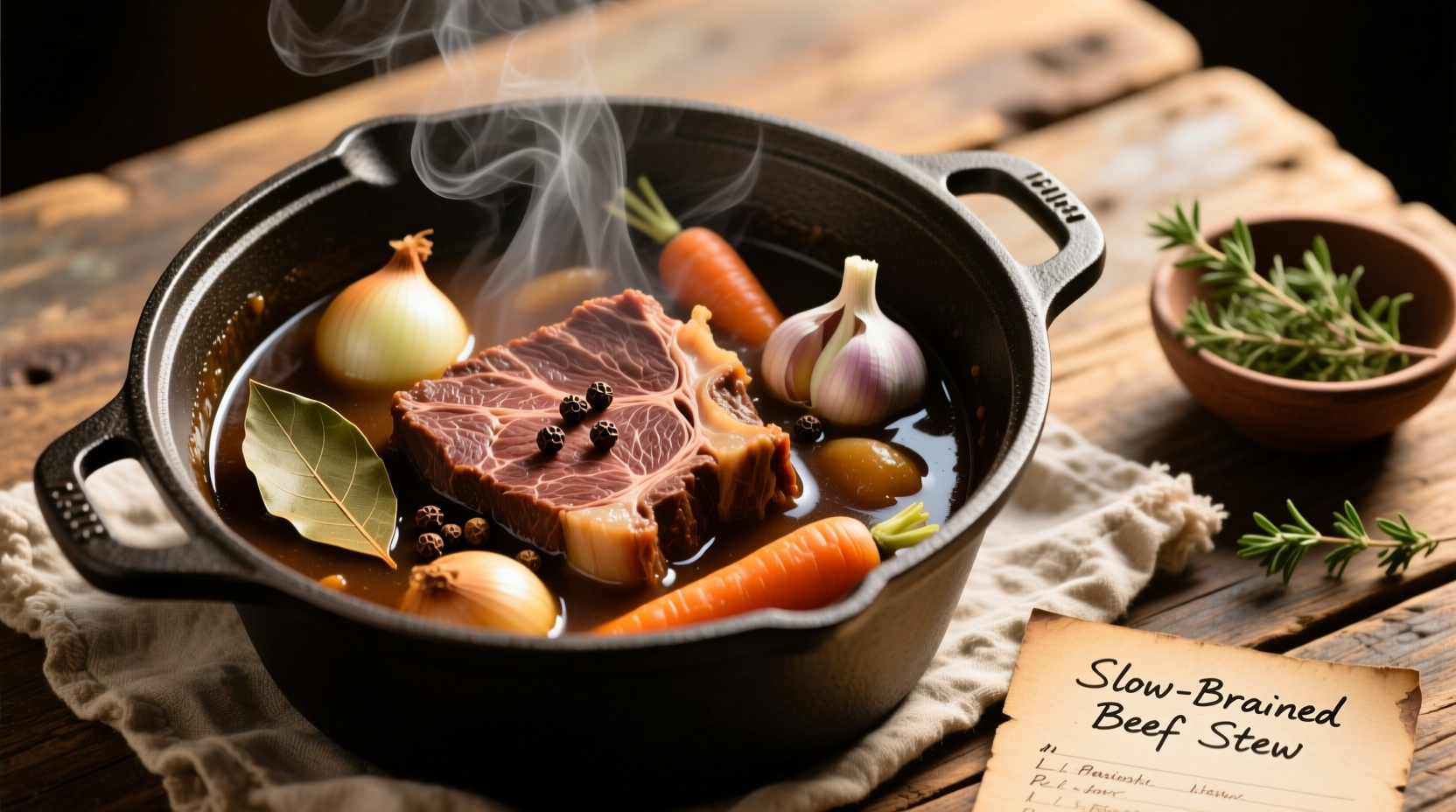When you bring home that package of stewing beef, you're holding culinary gold waiting to be unlocked. This affordable cut comes from hardworking muscles like chuck, round, or brisket—packed with connective tissue that requires slow, moist cooking methods to transform toughness into tenderness. Unlike steak cuts, stewing beef needs patience: those collagen fibers need 2-3 hours at 160-205°F (71-96°C) to dissolve into silky gelatin, creating that signature 'fall-apart' texture.
Why Stewing Beef Demands Special Treatment
According to the USDA's Safe Minimum Cooking Temperatures, beef should reach 145°F (63°C), but stewing beef requires going beyond this minimum. The real magic happens between 160-205°F where collagen hydrolysis occurs. As noted in McGee's On Food and Cooking, "collagen begins dissolving at 140°F but requires several hours at 180°F to fully convert." This scientific principle separates successful dishes from disappointing, rubbery results.
| Cooking Method | Optimal Time | Texture Result | Best Liquid Ratio |
|---|---|---|---|
| Stovetop Simmering | 2-3 hours | Fork-tender shreds | 3:1 liquid-to-meat |
| Slow Cooker | 6-8 hours low | Melts-in-mouth | 2:1 liquid-to-meat |
| Pressure Cooker | 45-60 minutes | Surprisingly tender | 1:1 liquid-to-meat |
Top 5 Dishes That Transform Stewing Beef
1. Classic Beef Stew (The Essential Foundation)
This isn't just 'soup with meat'—proper technique makes all the difference. Start by searing cubes in batches to develop fond (those browned bits on the pot bottom), which creates flavor depth. The University of Illinois Extension notes that the Maillard reaction at 285°F produces over 600 flavor compounds. Use equal parts beef broth and red wine for liquid, add root vegetables in the last 45 minutes, and finish with a slurry of flour and cold water to thicken. Pro tip: Refrigerate overnight—flavors deepen significantly.
2. Authentic Beef Chili (Beyond Basic Ground Beef)
For restaurant-quality chili, cut stewing beef into ½-inch cubes rather than using ground meat. Brown thoroughly, then add fire-roasted tomatoes, kidney beans, and a blend of dried chilies (ancho for depth, guajillo for fruitiness). The National Center for Home Food Preservation confirms chili safely freezes for up to 6 months. Secret ingredient: A square of dark chocolate added during the last 30 minutes balances acidity.
3. French Boeuf Bourguignon (Elegant Comfort Food)
Don't skip the pearl onions and mushrooms—these aren't garnishes but flavor amplifiers. As Julia Child emphasized, "the mushrooms absorb the wine sauce like little sponges." Use bacon lardons for fat (not olive oil), a full bottle of Pinot Noir, and cook until liquid reduces by half before adding meat. The BBC Food archive shows traditional recipes require 3 hours minimum for proper flavor integration.

4. Korean Galbi Jjim (Fusion Masterpiece)
This adaptation of traditional short rib stew works beautifully with stewing beef. The key is simmering in a soy-ginger-brown sugar broth until meat separates from any bone remnants. Food historians note Korean braising techniques evolved from royal court cuisine where tough cuts were transformed through slow cooking. Add Korean pear for natural sweetness and tenderizing enzymes—this isn't just flavor but science at work.
5. Jamaican Oxtail Stew (Unexpected Star)
Though traditionally made with oxtail, stewing beef creates an accessible version. The magic happens with allspice berries, Scotch bonnet peppers, and butter beans. According to the Caribbean Agricultural Research Institute, authentic versions include pimento (allspice) leaves for aroma. Cook until sauce thickens naturally—no thickeners needed—as collagen transforms into luxurious texture.
Avoid These 3 Costly Mistakes
Boiling Instead of Simmering
Rapid boiling makes meat tough by squeezing out juices. Maintain a gentle simmer where bubbles occasionally break the surface. As culinary scientist Harold McGee explains, "vigorous boiling causes muscle fibers to contract violently, expelling moisture."
Adding Vegetables Too Early
Root vegetables turn to mush when cooked 2+ hours. Add potatoes and carrots during the final 45 minutes. A University of Minnesota Extension study shows carrots retain 30% more nutrients when added later in cooking.
Skipping the Sear
That golden crust isn't just for looks—it creates complex flavor compounds through the Maillard reaction. Proper searing requires dry meat surfaces (pat cubes with paper towels) and a hot, heavy pot. Don't overcrowd the pan; work in batches for proper browning.
When Stewing Beef Isn't Your Best Choice
While versatile, stewing beef has limitations. Avoid using it for:
- Quick weeknight meals - Needs minimum 2 hours cooking time
- Stir-fries - Will remain tough regardless of high heat
- Raw preparations like tartare - Not suitable for rare/medium-rare cooking
Pro Storage & Prep Tips
Freeze uncooked stewing beef in portion-sized bags with 1 cup cooking liquid for future use—thaw overnight in refrigerator. When prepping, trim only large fat chunks; marbling melts during cooking for added flavor. For even cooking, cut cubes to uniform 1½-inch sizes. The American Meat Science Association confirms consistent sizing prevents some pieces from overcooking while others remain tough.
Transform Leftovers Creatively
Don't just reheat! Shred cooled beef and use for:
- Beef pot pie filling with flaky pastry topping
- Tacos with pickled onions and lime crema
- Philly cheesesteak sandwiches (skip the grilling)











 浙公网安备
33010002000092号
浙公网安备
33010002000092号 浙B2-20120091-4
浙B2-20120091-4